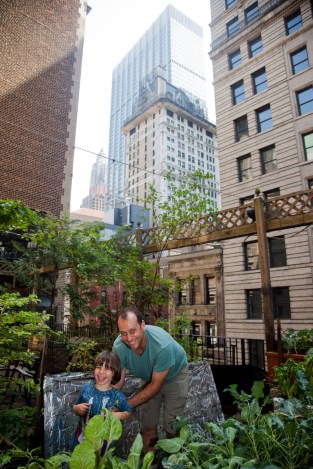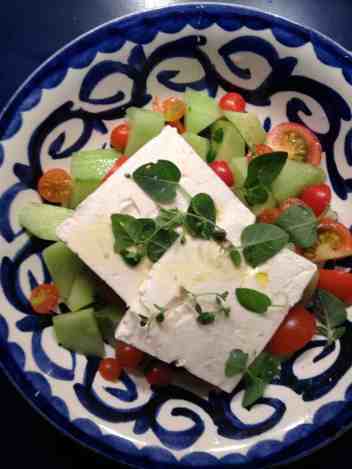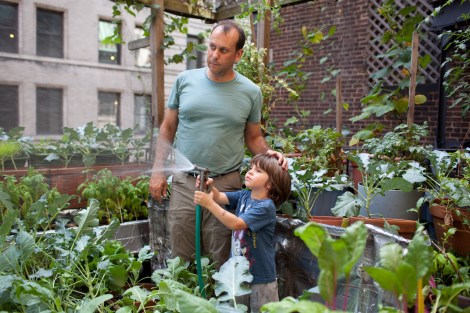Editor’s note: This article originally ran on Sept. 11, 2012. Here’s an update from Greenberg:
This year, I’m once again cobbling a September meal from my Ground Zero garden. I have snapper blues that my son and I caught at the Magnolia pier in Long Beach (though the town was still beat up and bruised by Sandy). I have lots of Ground Zero garden-grown Mexico midget tomatoes for a salad and a jar of preserved grape leaves from my single bottle winery which I call Chateau Nul. I had planned to make another bottle of Chateau Nul this year through my friend Christopher Nicolson at Red Hook Winery, but the birds unfortunately ate all the grapes in a midnight raid. But the biggest raid that didn’t happen was my co-op board’s threat to dismantle the garden entirely. They ran out of money fixing the other terraces in the building so the Ground Zero garden lives on for another year.
My plans for 2014 include mushrooms, currants, and maybe that long sought after tilapia in a barrel.

Greenberg with his son, Luke, in their Ground Zero garden. (Photo by Jackie Snowe.)
If you live at Ground Zero, as I do, the approach of Sept. 11 feels like the onset of an undertow current that threatens to drag you down and away from everything you’ve tried to accomplish these past 11 years. The barricades go up, constricting you into ever narrower pathways. The massive police presence, already tripled since Ground Zero’s next-door neighbor Zuccotti Park played host to the Occupy Wall Street protests, is prepared to triple once again. You have the distinct impression that you’ve done something wrong even before you’ve even thought about transgressing. But this Sept. 11, I am throwing off the chains of oppression and setting out to do something that I think neither the Ground Zero rebuilding architect Daniel Libeskind, nor Mayor Michael Bloomberg, nor the billionaire World Trade Center leaseholder Larry Silverstein have even contemplated.
Yes, this year at Ground Zero I will grow a meal.
For the last seven years I have lived in a 10th-floor apartment. During that time I have gradually assembled the elements of a functioning garden that, on a good year, can supply my family with bursts of vegetable matter from April to October. For whatever reason this year — the 11th Sept. 11 — all the different elements I started building back in 2005 have come together, and instead of having just a side dish here or a sprinkling of herbs there, I am on the verge of putting together an honest-to-goodness dinner grown (or caught) entirely at Ground Zero. It was a twisted kind of road map that led me to this moment of somewhat silly self sufficiency. And as is fitting in this post-9/11 environment of what seems like continual economic collapse, my anniversary meal will be organized around a Greek theme, classic and desperate at the same time. Here, then, is my menu.
Appetizer: Greek salad

A homegrown Greek salad. (Photo by Paul Greenberg.)
Of all the things I wanted from my vegetable garden when I started in 2005, a real khoriatiki, or “rustic salad” that we commonly know in America as a “Greek salad,” was what I wanted most. Summers spent at a friend’s Aegean retreat introduced me to the mellowness of a fresh (as opposed to a supermarket) green pepper, the particular sweetness of a just-off-the-vine cucumber, the glow of an overly ripe tomato. The only problem is that all of these vegetables require six to eight hours of sunlight a day, whereas my skyscraper-besieged terrace gets a scant four. The solution? Reflection and elevation. A few years ago I realized that four old screen doors moldering away on my terrace would make excellent frames for solar reflectors. And after investing about $10 in heavy duty aluminum foil and packing tape, I now have a full-on solar array that dupes my vegetables into blooming. Tomatoes and green peppers answered quickly to this formula, and I’ve had good success going on three years. The lone holdout was the cucumber that also bought into the bloom ruse but then disappointingly withered on the vine, year after year. But this year I took a page from last fall’s protestors and got my cucumbers to Occupy the Air Space. Instead of letting the cukes slither on the ground, I have trellised them skyward along the terrace’s back wall. Though they grow in weird shapes as they fight one another for every scrap of sun, they are healthy, palatable, and abundant. The final element, goat milk feta cheese, I will have to omit in my Greek salad. Alas, my building does not allow goats.
Second course: Blanched bitter field greens
While too little sun is the enemy and the challenge contained within the Ground Zero Greek salad, too much sun and heat poses the opposite problem for more delicate field greens (or “horta”) that should be on a proper Greek table. This isn’t a problem in springtime, as the vernal sun is blocked by a row of skyscrapers which I use as a kind of Stonehenge indicator system for timing my planting. Indeed, arugula, spinach, and lettuces all do well with this system from April to June. But in high summer a hardier plant is needed to withstand temperatures that can soar into the 100s even in September. Two years ago I found the solution during a research trip to Vietnam in the form of an odd vine called “Malabar spinach.” Not a true spinach, the Malabar actually climbs to heights exceeding 10 feet and relishes super-hot temperatures. And this year, with my trellis system fully operational, the climbing spinach has joined the cucumbers in my garden’s Olympian heights. The only drawback to Malabar spinach is that it comes out oddly slimy if fried in a skillet the way traditional horta should be cooked. But if the vegetable is blanched first in boiling water, the sliminess goes away and a very suitable side dish is the result.
Main course: Grilled wild New York City striped bass, Greek style

Photo by Jackie Snow.
There is a little bit of fish in everything I plant. Interspersed with my gardening habit is a serious fishing habit that compels me to range around Long Island and New England fishing from boat and shore year-round. After a fishing trip, the fillets go in the fridge, but the carcasses, guts, and heads typically end up in the garden, either deposited directly beneath tomato plants or in the row of compost cans I have along the Western wall. Turning the compost bins in spring, a gill plate or a spine will send me into a reverie of the previous year’s catch. This Sept. 11, I will endeavor to not only put fish guts into my neighborhood, but to also catch fish from my neighborhood and put them on my plate. Thanks to a combination of the Clean Water Act, the Sustainable Fisheries Act, and a multi-state conservation compact, American striped bass now make an impressive run through New York City waters in the fall and are catchable in good numbers from nearby Battery Park. It will take all night, and I’ll mingle with a somewhat rough crowd that gathers to fish seven-odd blocks south of me, but the reward is always worth it when one of these 10- to 30-pound beauties makes it into my net. And as to the question, “Can you really eat from New York City waters?” I answer with what the New York State Department of Environmental Conservation says: “Children under the age of 15 should eat no striped bass taken from Upper and Lower Bays of New York Harbor … Other people should eat no more than one meal/month of striped bass from these waters.” My son doesn’t like fish anyway, so I’ll go with it for my monthly meal, and I’ll grill it simply — Greek style like they do it in Astoria, Queens, with a little olive oil and fresh oregano from the garden.
Beverage and side dish: Fruit of the vine
To wash all this self-obtained food down, a truly brave vintage is required, and it’s here that the most impressive thing about my garden will be on display. Several years ago I wrote to the University of Minnesota and asked if they had a variety of grape that could withstand a limited amount of sunshine and extreme cold (for in addition to the blazing heat, my terrace in wintertime is blasted by an arctic chill that does away with most perennials instantly). The grape breeders at the U of M responded with a selection of cultivars that have rootstock tolerant to negative 40 degrees F. Two varieties perished quickly when I planted them, but two survived. One of them produces abundant grape leaves which I will stuff and serve to round out the Ground Zero Greek meal. But one lone vine actually did what it was supposed to do: produce abundant grapes amidst intolerable conditions. In 2011, on the anniversary of Sept. 11, I gathered enough grapes and crushed them in a drink cooler and produced a single bottle of wine. Not quite Greek retsina, I’m confident that it will be sufficiently harsh to match the meal.
Dessert
Sorry. No dessert. I had a few cherries, strawberries, and blueberries back in June, but they were sour and hard (like the times in which we live).
So that’s my menu. I have sized up the ripening crops, checked the fishing reports, and put my lone bottle of wine in the refrigerator. With a little parsimony I believe the meal will feed my whole family. I would be happy to have either Mr. Bloomberg, Mr. Libeskind, or Mr. Silverstein join us, but they should confer among themselves and figure out who can attend. I really only have enough food for one extra person.



